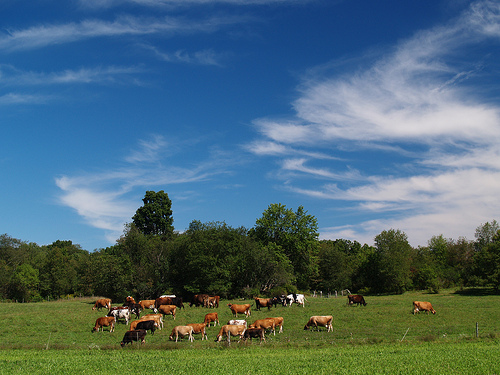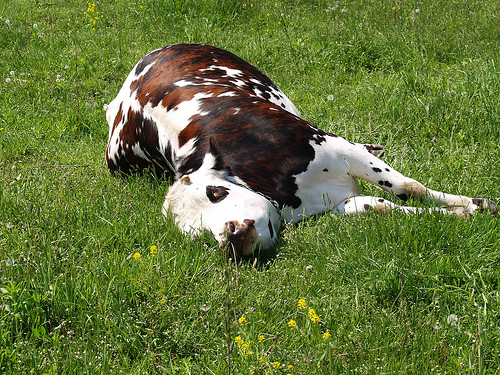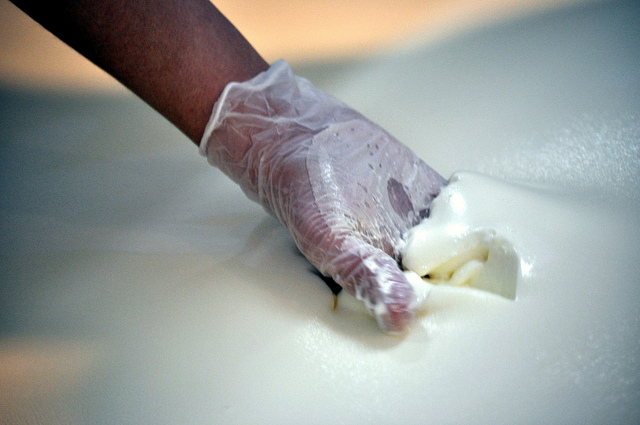In the latest installment of Farm Hopping, Scrapple and Sweetbreads go to Sprout Creek Farm! Twice!
 Sprout Creek Farm - Photo by Sprout Creek's Georgie Blaeser Sprout Creek Farm is a highly diversified farm with farm enterprises including dairy cows, sheep, pigs, meat & laying chickens, turkeys, an on-farm retail market and more. The farm is structured as a non-profit and is operated by the Society of the Sacred Heart. Sprout is most well-known for its cheese and youth summer camp. The farm produces 15 varieties of cheese from approximately 400,000 pounds of milk from herds of ~40 cows and ~65 goats. As if Sprout’s excellent cheese wasn’t enough of a highlight, the farm also offers kids the opportunity to spend the summer on the farm participating in all aspects of farming. Gardening, milking, animal husbandry, you name it! The staff’s ability to teach 10 yrs olds about farming turned out to be perfect for getting us up to speed!
Sprout Creek Farm - Photo by Sprout Creek's Georgie Blaeser Sprout Creek Farm is a highly diversified farm with farm enterprises including dairy cows, sheep, pigs, meat & laying chickens, turkeys, an on-farm retail market and more. The farm is structured as a non-profit and is operated by the Society of the Sacred Heart. Sprout is most well-known for its cheese and youth summer camp. The farm produces 15 varieties of cheese from approximately 400,000 pounds of milk from herds of ~40 cows and ~65 goats. As if Sprout’s excellent cheese wasn’t enough of a highlight, the farm also offers kids the opportunity to spend the summer on the farm participating in all aspects of farming. Gardening, milking, animal husbandry, you name it! The staff’s ability to teach 10 yrs olds about farming turned out to be perfect for getting us up to speed! Trip One
We first arrived at Sprout Creek on a beautiful spring afternoon in New York and met Margo Morris, the gentle matriarch of the farm. What excited us about Margo was her keen interest in helping us learn. She immediately sat us down for a chat so that she could understand what we were all about and what we were trying to accomplish. This wasn’t one of those farm tours where you show up, see the place and then head out. Margo knew that Sprout had a lot to offer and she wanted to tailor her explanations and our visit to the various farm enterprises that interested us most. As we sat down with Margo we explained our backgrounds and why we wanted to be farmers. Her eyes lit up as she recalled times of her past in Connecticut when she first started farming in the 1970’s. The more we discussed our thoughts and values the more we connected and we knew our visit to Sprout Creek would change our lives.
 Sprout Creek Farm Cows on Pasture - Photo by Sprout Creek's Georgie Blaeser Our first afternoon with Margo we watched the cows and goats get milked, took a trip to see cows on pasture, felt our hearts beat with excitement as we saw lambs bounce stiff-leggedly across the field and helped round up some rogue laying hens. All along Margo patiently answered our questions and explained the methods behind Sprout Creek’s practices. At the end of our visit we happily agreed to come back for a full day later that spring and really put in some work.
Sprout Creek Farm Cows on Pasture - Photo by Sprout Creek's Georgie Blaeser Our first afternoon with Margo we watched the cows and goats get milked, took a trip to see cows on pasture, felt our hearts beat with excitement as we saw lambs bounce stiff-leggedly across the field and helped round up some rogue laying hens. All along Margo patiently answered our questions and explained the methods behind Sprout Creek’s practices. At the end of our visit we happily agreed to come back for a full day later that spring and really put in some work.Trip Two
At 4:45am on a beautiful Saturday morning we could be found rustling around our friend’s farmhouse in Red Hook, NY admiring the breathtaking sunrise and heading out for the drive down to Poughkeepsie to participate in the morning milkings. At 6am the farm was already a bustlin’. The farm manager Mike was pulling in on a tractor and local high school and college students were bringing in the cows from pasture. We joined the crew and tossed some hay down from the loft for the goats and listened as Mike patiently guided us in our morning chores.
Sweetbreads has a strong affinity for cows so she joined in with the cow milking team. Scrapple took the opportunity to tag along with the goat milking team. One way to learn fast is by doing and with Sprout’s focus on education we were easily on-boarded and attaching suction cups to teats in no time. We weren’t allowed to do the preliminary testing of the milk, but we could apply the “pre-dip” to the teats, attach/detach the milkers and apply the “post-dip”. Before each animal is milked one of the team members hand strips a few squirts of milk into a screened jar keeping an eye out for lumps and discoloration. Anything that doesn’t look normal is automatically flagged and that milk won’t make it into the cheese vats. Our job of applying pre-dip was to make sure the teat is clean and the post-dip lubricates the teats, which can become dry after milking. As Mike finished testing the milk we would follow with the pre-dip and the milkers, slowly making the rounds between animals. Some milked out quickly and others took longer, which with the goats was a constant waiting and watching. The cow milkers have flashing lights indicating when a cow is done, so it’s bit easier. All in all it probably took 30 or 40 minutes to get the goats and cows milked and then we walked them back out to fresh pasture. Sprout believes in rotational grazing and the cows receive a fresh paddock full of grass on an almost daily basis.
At 4:45am on a beautiful Saturday morning we could be found rustling around our friend’s farmhouse in Red Hook, NY admiring the breathtaking sunrise and heading out for the drive down to Poughkeepsie to participate in the morning milkings. At 6am the farm was already a bustlin’. The farm manager Mike was pulling in on a tractor and local high school and college students were bringing in the cows from pasture. We joined the crew and tossed some hay down from the loft for the goats and listened as Mike patiently guided us in our morning chores.
Sweetbreads has a strong affinity for cows so she joined in with the cow milking team. Scrapple took the opportunity to tag along with the goat milking team. One way to learn fast is by doing and with Sprout’s focus on education we were easily on-boarded and attaching suction cups to teats in no time. We weren’t allowed to do the preliminary testing of the milk, but we could apply the “pre-dip” to the teats, attach/detach the milkers and apply the “post-dip”. Before each animal is milked one of the team members hand strips a few squirts of milk into a screened jar keeping an eye out for lumps and discoloration. Anything that doesn’t look normal is automatically flagged and that milk won’t make it into the cheese vats. Our job of applying pre-dip was to make sure the teat is clean and the post-dip lubricates the teats, which can become dry after milking. As Mike finished testing the milk we would follow with the pre-dip and the milkers, slowly making the rounds between animals. Some milked out quickly and others took longer, which with the goats was a constant waiting and watching. The cow milkers have flashing lights indicating when a cow is done, so it’s bit easier. All in all it probably took 30 or 40 minutes to get the goats and cows milked and then we walked them back out to fresh pasture. Sprout believes in rotational grazing and the cows receive a fresh paddock full of grass on an almost daily basis.
 Pasture Nap - Photo by Sprout Creek's Georgie Blaeser
Pasture Nap - Photo by Sprout Creek's Georgie Blaeser Once the cows were happily grazing and ruminating again we found our way back to the make room where cheesemaker Colin McGrath was getting set up for the day. His helper Marcelo was running around frantically knowing that if Colin was going to spend the day holding our hands that he was gonna be picking up the slack! We donned our hairnets and booties and entered the fantastic world of cheesemaking. Sprout Creek has a 400 gallon vat and we were going to use it to make a raw cow’s milk cheese called Bogart. Bogart is a semi-firm cheese which ages very nicely and can be sold within a couple months or after as long as a year.
When the milk first comes from the cow’s udder it flows into a chill tank that takes the temp down from about 100 degrees to around 38 to 40 degrees to keep until it’s time to make cheese. When the time comes, it is piped into the cheese vat and heated up to around 90 degrees - the perfect temperature for the culture to “ripen” the milk. The starter culture is added and the bacteria in the culture begin to “eat” the lactose in the warm milk, producing lactic acid, changing the pH of the milk, and beginning the separation of curds from whey. After about an hour we added the rennet which coagulates the milk protein into a solid curd. Colin put a plastic yogurt lid onto the top of the milk and showed us how it glided smoothly across the vat when you gave it a little tap. During the next 20-30 minutes we tried tapping the lid every few minutes until finally it stopped moving as if glued onto the milk. At this point we multiplied the time it had taken for the milk to set (30 min) by 3. This gave us a total flocculation time of 90 minutes. Flocculation is the precipitation of suspended solids (curd) out of a liquid (whey). As 30 minutes had already passed, we went and talked and tasted cheese for another hour before heading back to the vat.
It was time to test for a “clean break”! Colin had us slip our gloved hands diagonally into the warm gel and then slowly pull our index and middle fingers towards the surface, as if guestering “come here”. The mass bulged up and then cleanly split open, confirming that the curd was set and ready to be cut!
 The "clean break" - Photo by Sprout Creek's Georgie Blaeser
The "clean break" - Photo by Sprout Creek's Georgie Blaeser We slipped the harp-like curd knives, one strung horizontally and one vertically, into the vat and ran them across the length of it as fast as we could to get a smooth cut. We traded sides, cut again, and then repeated the process across the width as well, creating little cubes of curd. The curd was left to rest and heal for a few minutes before being heated back up again and gently agitated, helping to separate even more whey from it.
Finally the whey was drained off and we scooped out the the curds to fill the molds. Colin doesn’t use a cheese press in any of his processes and instead relies on gravity and sequence of mold flips to press out the excess liquids. The flip is a simple yet tricky technique - clearly calling for “the touch” to get it right. The mold is quickly turned on its side, spun around while tilting to move the cheese to the other end, and then again righted - hopefully with the other end up and a nice compact wheel in the bottom. Colin let us each try one, and while we succeeded in not losing the curd all over the floor, our flipped wheels looked a little abused and unsettled. I guess it takes some practice!
We capped off the day of cheesemaking with a wonderful sampling of ten of Sprout’s cheeses. We must say that there wasn’t a one we wouldn’t happily eat again and there were several we would eat a few times a day if we could! We brought home a cooler full.
After cheesemaking we took our lunch break near the pigs (a bit counter-intuitive, eh?) and watched as they rooted around and sunbathed in their mud-baths. We fed them some greens and watched as they happily chomped away and we even gave them a good back scratching. It always amuses us how playful pigs are and how much they love a good scratch! Maybe that’s one reason Scrapple loves pigs so much, he can really relate.
After our late lunch we headed back out to the pastures to check on the “dry” cow herd and toss some salt and minerals to the sheep. The dry cows are cows that are not in lactation and are a few months away from giving birth again. Sprout keeps a rotation of lactating and dry cows to facilitate year-round cheesemaking. In order to keep the dry cows from becoming unfriendly to people Sprout makes sure to visit them each day and bring them some treats. There’s nothing like having a lumbering Brown Swiss walk right up to your hand and give it a big lick!
It was a wonderful day that gave us much food for thought in addition to the cheese in our bellies. We had been thinking about what the centerpiece of our farm might be. Something that would add value to the raw materials we could grow on the farm and also act as an introduction to the other nutritious pastured food we hope to provide. We had loved the actual act of making cheese as well as the interaction with the milking cows and goats. There is also no question that we love to eat cheese, in fact, Sweetbreads could live off of it. Could cheesemaking be it? We’ll keep you posted! In the meantime, we have a new research topic!

